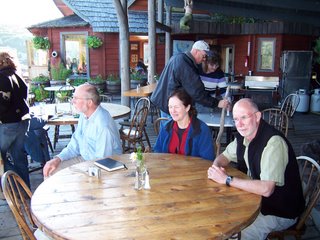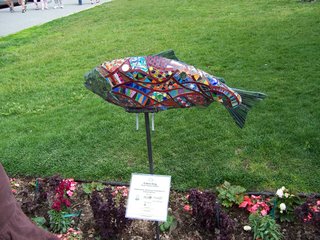 The family on Hinchinbrook
The family on Hinchinbrook Hauling gear
Hauling gear Gail leaving
Gail leaving Gail
Gail Chenega
Chenega Hook Point------Don't ask me how these got on here twice.
Hook Point------Don't ask me how these got on here twice. This is Gail
This is Gail The Chenega
The Chenega Hook Point
Hook Point July 10, 2006
Gail runs a flying service out of Cordova, Alaska called Fishing and Flying. She has to be close to my age. She came to Alaska with her three year old son in 1965, the year after the earthquake and the year after Arkansas was national champions (which was also a form of earthquake), to teach school. A few years later she was a bush pilot.
We came to Cordova from Whittier across the entire length of Prince William Sound on Chenega, the fast ferry. We passed glaciers, waterfalls and rocky islands; saw porpoises, sea otters, glaucous-winged gulls, and a tufted puffin; and, far away next to a blue glacier, a white twelve story Princes Cruise Liner. Near Bligh Reef, the place where the Exxon Valdez ran aground, we crossed the oil tanker super highway; the course the Exxon Valdez would have taken had humans not made another tragic mistake.
Chenega makes the trip in a little over three hours. The slow ferry takes almost fifteen hours. Chenega carried not only the four Banks adults and two grandkids, but also David’s Honda Pilot crammed with everything necessary and desirable for several days of luxury wilderness camping. We brought David’s car because the stuff wouldn’t all fit in my Highlander.
Gail got all the gear in the back of a Beaver, the workhorse of the Alaska bush pilots, and still had room for the family. They haven’t made Beavers since 1956. Gail got her Beaver for a great price after a former owner crashed it into the side of an icy mountain. Gail, her son and her “mechanic” (husband) rebuilt the plane so she could fly us and others into wilderness.
We flew low, low enough to stay under sagging clouds and low enough to see a brown bear and her cub. We were also low enough to see the rotting boats next to the crumbling fish processing plant in the Copper River Delta. The plant went out of business after the earthquake lifted the ground under the plant six feet. The sea moved several miles in the direction of Hawaii, changing all the channels in the delta, trapping the boats at the plant, and denying future access to the plant by the big fishing boats.
We flew over the Copper River Delta, across a sliver of Prince William Sound, around the rocks piled on Hook Point, and along a beach on the west side of Hinchinbrook Island. Gail pointed to a sign in the trees on the far side of a sandy beach that had to be as wide as the mall in DC. “That is where your cabin is,” she said. I couldn’t see anything indicating the presence of humans; no trails, no beach umbrellas, no reindeer hot dog stands, and no sign or cabin.
Gail made a low turn over the white foaming surf wallowing onto a beach as flat as snow on a frozen lake. The water pushing the surf onto that beach is called the Gulf of Alaska, which is connected to the Pacific. If we flew out to sea and had enough gas, a co-pilot, some wine and a place to go to the bathroom, the first land we would reach would be Hawaii.
Gail put the Beaver on the beach with out waking Cole and with out jiggling the fat around my middle. We unloaded, said good-by and Gail and her Beaver floated off into the thick salty mist. We were alone with the eagles, gulls, deer (Sitka black tail), bear, plovers and a pile of gear that had to be hauled to the little A-frame Forest Service cabin sitting back in the spruce trees over a half mile across the sand. The kids were already digging in the soft sand.










































